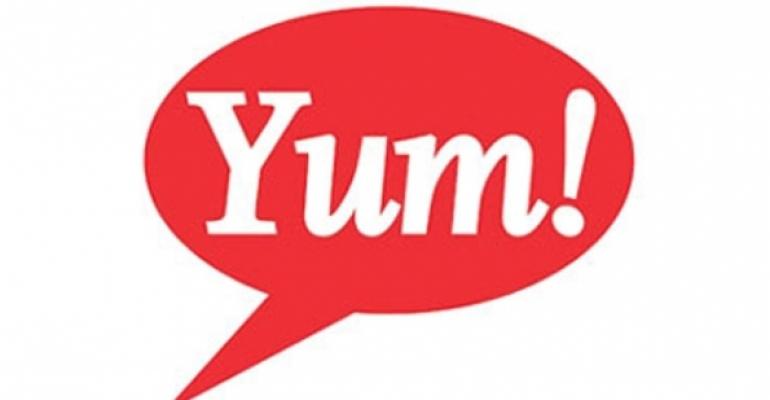Officials for Louisville, Ky.-based Yum! Brands Inc. admitted to investors that fiscal 2013 would be “disappointing,” based on the six-to-nine-month time frame the company is projecting for a full sales recovery in China for its KFC brand.
But chief executive David Novak reiterated during Yum’s first-quarter earnings call that the company intends to come back even stronger next year, and brand-building efforts in China and continued margin improvements in the United States and Yum! Restaurants International, or YRI, would be Yum’s focus as it tries to get back on track, he said.
“When you have great brands, you just have to keep doing the things that build a brand, and you can come back,” he said. “Every great brand comes back, and KFC is in a powerful position in China. … The big message we have for Yum! Brands this year is, ‘Stay the course.’”
First-quarter operating profit fell 41 percent in China, where KFC has been a leading brand for Yum for years. However, because negative publicity over the safety of that country’s supply chain for chicken implicated two former KFC suppliers, the brand’s traffic plummeted from December 2012 through March 2013. Same-store sales declines began narrowing in March and pointing toward an end-of-the-year recovery, but the first week of April brought news of an avian-flu outbreak near Shanghai, derailing any momentum KFC might have built, officials said.
Chief financial officer Patrick Grismer said Yum expects April same-store sales to decline 30 percent at KFC in China.
The difficult news out of China obscured positive developments out of other divisions for Yum, such as the United States, which will have positive net new-unit development in fiscal 2013 for the second consecutive year, officials said. Led mostly by Taco Bell — whose 6-percent gain in first-quarter same-store sales in the U.S. lapped a year-earlier gain of 6-percent — the U.S. division’s first-quarter restaurant margin grew 2.4 percent and operating profit increased 5 percent.
Weak traffic batters China margins
Most of securities analysts’ attention during the call remained focused on China, where restaurant-level margins decreased 7 percent in the first quarter, even with better-than-expected sales during Chinese New Year in February and benefits to Yum’s cost of goods sold.
Food costs deflated about 5 percent in the quarter, adding to a 3-percent benefit from prior pricing actions that somewhat blunted the impact of a steep decline in guest counts, Grismer said.
“There were a number of moving pieces on margins, but the most significant variable in that equation is transactions,” Grismer said. “The transactions did hit us significantly in the first quarter, and as that reverses it will certainly work to our advantage over the course of the rest of the year.”
At this point, Yum is not changing its full-year outlook for inflation of mid-single-digit increases for food costs and mid-teen increases for labor, he added. Over the course of the year, as KFC puts the supply chain and avian-flu controversies behind it, leveraging better top-line sales should still put 20-percent restaurant-level margins within reach, Grismer said.
“It’s not just comps that are going to get us there,” he said. “Certainly in the short term, the transaction recovery is going to be the single-biggest driver of margin improvement. However, there are a couple of things to keep in mind.”
He cited new sales layers at existing restaurants, like 24-hour operations at KFC and a breakfast platform at Pizza Hut Casual Dining.
“There’s also portfolio shift,” he added. "For the KFC brand, we’re shifting from Tier 1 and Tier 2 coastal cities to Tier 3 and below cities inland, where the margins are significantly higher. And we’ll continue to shift our new-unit program from KFC to Pizza Hut. Even in a quarter where same-store sales were down for Pizza Hut Casual Dining, margins were still above 20 percent and even closer to 30 percent in interior cities.”
Flying past avian flu
Novak said Yum’s confidence for a recovery by the end of 2013 in China stems from its experience with prior avian-flu scares, like the last one that occurred in 2005. The impact of that situation was “dramatic” in the short term but lasted for about three months, which is about the same time frame Yum expects for the current situation.
Grismer agreed, citing same-store sales in China coming back in February and March to levels Yum had projected, before the new fears of avian flu arose.
“Before this recent publicity of avian flu we were seeing the recovery, and we continue to expect, therefore, that full recovery will happen, particularly given that we expect this dramatic impact of avian flu will persist for only about three months or so,” he said. “We’ve weathered many storms like this, so we do have a number of data points to inform our point of view, and based on what we saw happen in Q1 and March, we’re looking at a six- to nine-month recovery period.”
As such, Yum will continue with previously stated plans to open at least 700 new restaurants in China in 2013, Novak said.
KFC China’s quality assurance marketing campaign, along with some new products and value promotions to come later this year, would lay the groundwork for resuming the division’s leading profit growth once it weathers 2013, Novak added.
“We expect to go into 2014 with KFC being stronger than ever,” he said.
Including the 5,480 restaurants in China, Yum operates or franchises more than 39,000 locations of KFC, Pizza Hut and Taco Bell in 130 countries.
Contact Mark Brandau at [email protected].
Follow him on Twitter: @Mark_from_NRN





